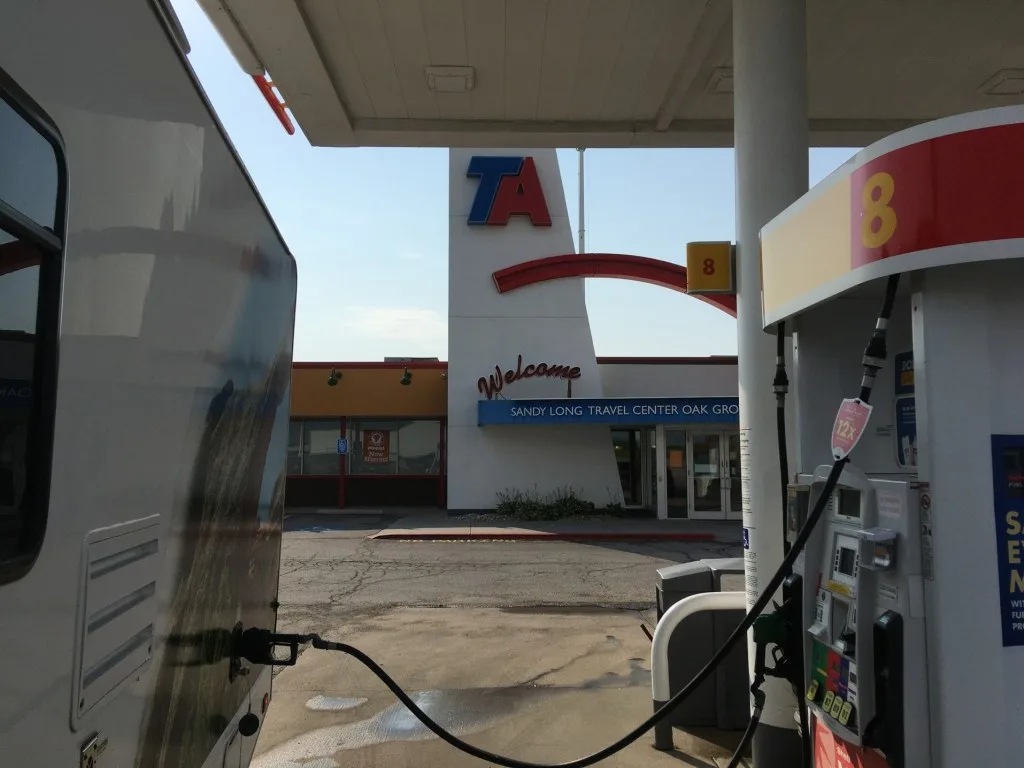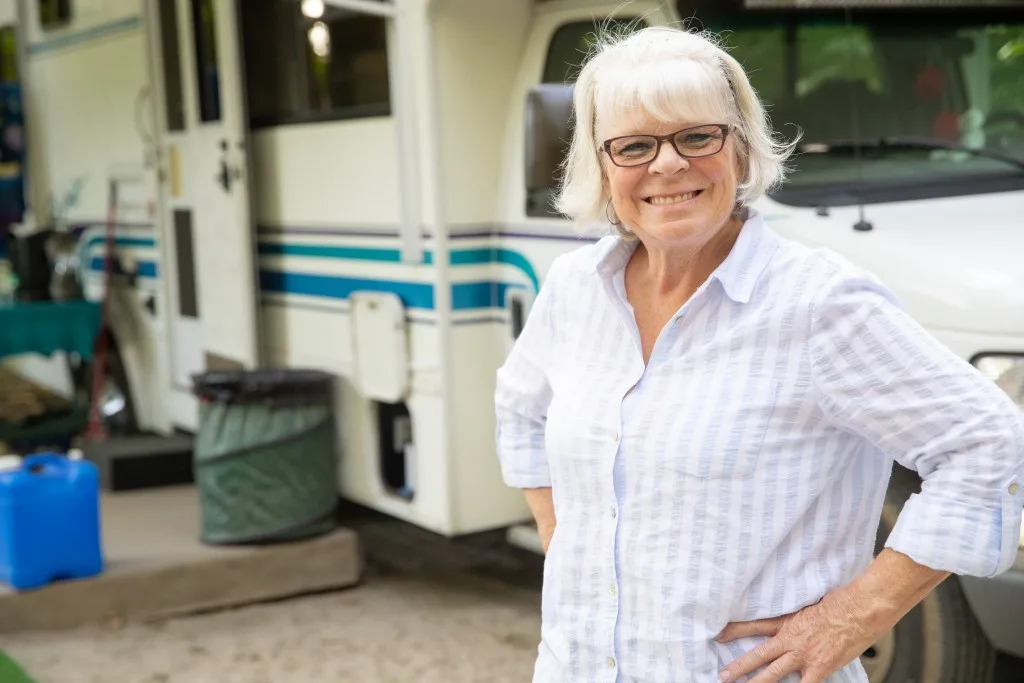With rising fuel prices across the country, everyone is looking for a way to save. This includes RVers whose rigs guzzle gas. So if there are tips to getting more MPGs, RVers want to know them.
Let’s look at a few ways to increase the fuel efficiency of RVs and what to expect at the pump if you travel with empty holding tanks.
Do RVs Get Good Gas Mileage?
If you want to save money at the pump, don’t buy an RV. Travelers don’t go RVing because of the fuel efficiency. They go for the experiences and adventures.
Most Class A motorhomes will get 6 to 12 MPGs. They’re the least fuel-efficient option because of their length and weight. On the other hand, Class B vans average 16 to 25 MPGs because of their smaller size.
How Many Miles Per Gallon Does a 25-Foot RV Get?
A 25-foot Class A will have a different fuel efficiency than a 25-foot Class C because of the difference in weight. A Class A chassis is heavier. These models tend to be the most luxurious options with heavier amenities. For example, a porcelain tile floor instead of laminate will add weight. Additionally, a Class A can tow a heavier vehicle behind it than a Class C.
This also reduces fuel efficiency. So a 25-foot Class A will get the upper end of the range, probably 10 to 12 miles per gallon. A 25-foot Class C is an average size for that type of RV, so it’ll range between 10 to 18 miles per gallon.

Should You Drive RV With Full Water Tank?
If you want to go boondocking for several days, you don’t have many options other than driving with a full fresh water tank. You must supply your own water for washing and flushing the toilet. But if you can fill up as close to your final destination as possible, this will increase your fuel efficiency. Water is heavy, which impacts your fuel efficiency. The less you need to drive with the added weight, the better.
Just one gallon of water weighs about 8 pounds. This means if you fill a 75-gallon fresh water tank, you’ll be adding almost 600 pounds to the overall weight of your RV. That’s a lot of additional weight to transport, putting pressure on the tank to handle that amount of weight while on the road.
Can I Drive With a Full Black Tank?
If you go boondocking, you may not have any other choice but to drive at least a few miles with a full black tank before you reach a dump station. If you can keep your distance to a minimum, you’ll protect your black tank from the added pressure of holding a large amount of weight while in motion. It’s very different when your black tank is full and you remain stationary at a campground.
If you have a 55-gallon black tank filled with waste, you’ll add liquid and solid weight to your rig. Even if it’s full of only liquid, you could add 440 extra pounds. So the less you travel with a full tank, the better. You’ll protect your tank from added wear and have fewer miles you have to travel with hundreds of extra pounds.
Pro Tip: Use our tips on where to dump your black tank while boondocking to keep your camper sweet smelling.
Will Your RV Get Better MPGs If You Drive With Empty Holding Tanks?
Yes, you can get better miles per gallon with empty holding tanks. Anytime you can lighten the load of your RV, your miles per gallon will increase. Go grocery shopping once you arrive at your destination rather than driving with a full pantry and refrigerator.
Decrease your cargo weight by packing lighter and traveling with less stuff. This is the same for the holding tanks. Traveling with empty holding tanks means a more lightweight RV, increasing fuel efficiency.

How Can I Increase the MPG on My RV?
You can’t change the length of your rig. But you can change the weight, affecting your MPGs. It’s also important to check the tire pressure regularly and maintain a steady speed if you want to increase fuel efficiency.
Decrease Your Cargo Weight
There are necessities when traveling. You must pack a certain amount of clothes, dishes, toiletries, and other household items to have an enjoyable camping experience. But you don’t need every kitchen gadget you have at home. You don’t need five pairs of shoes for a weekend trip. Do your best to pack light, thus decreasing your cargo weight and increasing your miles per gallon.
Check Tire Pressure Regularly
If you drive with low tire pressure, you’ll experience more resistance because more of the tire surface is on the road. The engine has to work harder to battle the increased friction and larger tire footprint. If you check your tires before every trip, you’ll keep them properly inflated, thus helping the RV to travel safer and with better gas mileage.
Pro Tip: Check your tire pressure with ease by using this tire pressure monitoring tool.
Maintain a Steady Speed
Try to maintain a speed of around 55 to 60 miles per hour. Once you get above 60, you start to lose fuel efficiency. Let the semi-trucks and passenger vehicles pass you on the interstate while you safely drive in the right lane. You’ll get better MPGs if you can travel via the interstate instead of back roads. You can maintain a steady speed instead of speeding up and slowing down at curves, hills, and stop lights.

How Much Does It Cost to Fill Up an RV?
Fuel costs fluctuate all over the country. What you pay at the pump in California differs from the price in Louisiana. The type of fuel also affects the overall cost. Diesel is more expensive than gas.
But if you fill up a 100-gallon Class A fuel tank with gas for $5 a gallon, you’ll pay $500. If you fill up a 100-gallon Class A fuel tank with diesel for $6 a gallon, you’ll pay $600. Keep in mind a full fuel tank will add weight to your overall RV, too.
Is Driving with Full Holding Tanks Worth It?
If you near the cargo carrying capacity of your RV, you shouldn’t drive with full holding tanks. The added weight will put you over the safe cargo carrying limit, putting your RV at risk for damage.
If you stay at a campsite with hookups, you don’t need to have full holding tanks. This is also true when leaving a site with a dump station or sewer hookups. Empty your tanks before you hit the road. You’ll reduce the overall weight of your RV and the pressure on the holding tanks.
However, if you head out for a week of boondocking, you’ll need to fill up. Just do it as close to your destination as possible. Try to empty your tanks into a portable waste tank and visit a dump station before heading out where possible. Reduce the added weight to increase MPGs and take care of your holding tanks.
Have you ever driven with full tanks? Tell us in the comments!
Discover the Best Free Camping Across the USA
To be honest with you, we hate paying for camping. There are so many free campsites in America (with complete privacy).
You should give it a try!
As a matter of fact, these free campsites are yours. Every time you pay federal taxes, you’re contributing to these lands.
Become a FREE CAMPING INSIDER and join the 100,000 campers that love to score the best site!
We’ll send you the 50 Best Free Campsites in the USA (one per state). Access the list by submitting your email below: